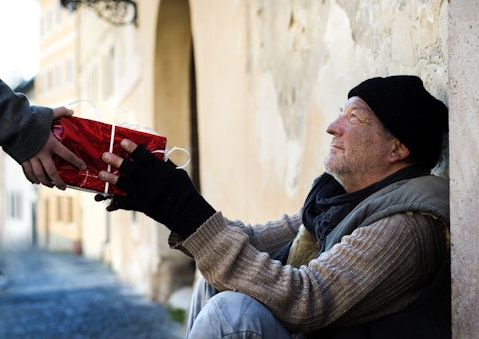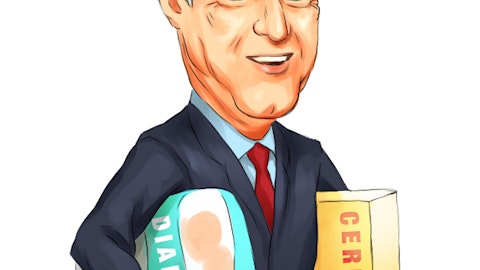In this article, we shall discuss the world’s 50 poorest countries based on percentage of population living below the poverty line. To skip our detailed analysis of global poverty and the efforts underway to alleviate poverty rates and meet the climate challenges, go directly and see World’s 10 Poorest Countries Based on Percentage of Population Below Poverty Line.
According to the Oxford Poverty and Development Initiative, more than 18% of the global population lives in acute multidimensional poverty. More than half of this population resides in Sub-Saharan Africa and over a third live in South Asia. In the United States, the end of unprecedented pandemic-era federal benefits have exacerbated rates of child poverty, creating a raging gap for under-resourced state administrations to fill, according to Bloomberg. In an effort to curb surging poverty amongst children in the United States, eleven states have built upon a refundable child tax credit, following the halt of the federal service in 2021 which enabled poorer families to rake in up to $3600 per child. In 2021, the federal benefits aided in reducing the child-poverty rate in the country by nearly half to 5.2%. However, the rate peaked at 12.4% at the end of 2022 after the duration of the federal program was over. In July 2023, more than 20% of children across the United States were living in abject poverty, according to the Columbia University Tracker. In order to mitigate some of the effects of the federal program, numerous states in the United States like New Mexico, Maryland, and Minnesota have implemented some form of tax credit for families which has aided in relieving some of the pressure exerted by exacerbating poverty. You can read more on poverty in the United States in our article 25 States with the Highest Poverty Rates in the US.
Companies on the Frontlines of the Fight Against Poverty
As poverty rates around the world skyrocket, especially in the world’s 50 poorest countries, many corporations are waking up to the revenue and profit opportunities to provide affordable products and services to the poorest segments of the global population. One of these proactive companies is CVS Health Corporation (NYSE:CVS), which provides equal access to employment in poorer communities in the world’s 50 poorest countries, making quality healthcare more accessible. In January 2023, CVS Health Corporation (NYSE:CVS) launched the CVS Health Community Equity Alliance to acutely address barriers to care in underserved, poorer communities across the US. The company is also leading the initiative against the ‘pink tax’, a premium placed on items branded for women even when they are exactly identical to products reserved for men. In October 2022, CVS Health Corporation (NYSE:CVS) claimed that it was slashing the price on CVS-brand period products by more than 25% in stores across the US to account for the increased sales tax on the products in more than 12 states. The targeted products included CVS-brand pads, tampons, liners, and menstrual cups.
Another company standing on the frontlines of the fight against poverty especially in the world’s 50 poorest countries is Nestle S.A. (OTC:NSRGY). Nestle S.A. (OTC:NSRGY) has launched numerous initiatives across many countries to alleviate poverty rates and ensure premium quality nutrition to even the world’s most impoverished communities. The company has implemented numerous initiatives for poverty reduction aimed at women, farmers, children, and the larger rural communities in countries Nestle S.A. (OTC:NSRGY) operates in.
Mastercard Inc. (NYSE:MA) is another company which has diverted major investments into poverty alleviation initiatives and to capitalize on under-resourced segments of the market in the world’s 50 poorest countries to generate more revenue and maximize profit. The company has pursued initiatives targeted at financial inclusion, education, and training. Mastercard Inc. (NYSE:MA), under the ‘Young Africa Works’ strategy, focuses on developing solutions for Africa’s youth employment challenge, understanding incredibly well that securing meaningful employment is a sustainable and durable avenue out of poverty. Mastercard Inc. (NYSE:MA) has also set up the ‘Mastercard Foundation Fund for Rural Prosperity’ to maximize the capacity of the global financial industry and for-profit business sector to improve access to and deliver affordable financial services to poorer communities across rural landscapes in the world’s 50 poorest countries based on the percentage of population living below the poverty line. You can read more on companies leading the fight against poverty in our coverage of the 40 Countries With Highest Rates Of Poverty.
Achieving Poverty and Sustainability Imperatives: An Analysis
According to an analysis by McKinsey, there is a deep interconnection between growth, inclusion, and sustainability. As the climate crisis exacerbates and companies race to implement sustainability measures as soon as possible, an argument is often made by certain segments of the community that there is no sustainable alternative to the carbon-focused economy and that any large-scale move towards to net-zero would disbalance the global economy and push millions back into abject poverty. However, the report by McKinsey looks into the intricacies of the economics of addressing both poverty and climate change in a decisive way primarily in the world’s 50 poorest countries.
The report focuses on established global targets without imposing any restriction and/or constraint on the targets. On the sustainability end of the equation, the Paris Agreement proposed an extensive framework to limit global temperature rise to below 2.0°C, leading to numerous countries around the world, including the world’s 50 poorest countries, committing to net-zero emissions. On the inclusion end of the equation, the report reserves its focus on the global effort to alleviate extreme poverty and set higher bars for living standards. Countries around the world have begun to divert increased investments on the twin priorities, with more than ninety percent of the $1.4 trillion global spending reserved towards net-zero spending was made by the public sector in 2021. More than 20 percent of the consumption of the percentage of population living below the poverty line was supplemented by capital derived from public and social spending on in-kind transfers in 2021.
The World Bank’s extreme poverty line was updated recently from $1.90 to $2.15 per person per day (in purchasing power parity terms). However, since billions of people have begun to exit extreme poverty in the world’s 50 poorest countries, the world needs a complementary benchmark to trace progress toward a higher living standard, especially since nearly all the people of exited poverty in recent years have limited access to quality healthcare, adequate education, and decent housing. There is a glaring need to understand and adapt current markers to the fact that when people rise above poverty meaningfully, outcomes tend to improve across the board, including childhood mortality, life expectancy, years of schooling, life satisfaction, and digital and financial inclusion. This improved marker needs to be quantified by using data incorporating consumption-based metrics, taxes, and direct transfers. Financial empowerment needs to be a per-person metric, especially since the world’s 50 poorest countries tend to follow communal living patterns and families which pool in their resources will be better positioned to meet basic needs.

Copyright: halfpoint / 123RF Stock Photo
Our Methodology
To compile our list of the world’s 50 poorest countries based on percentage of population living below the poverty line, we used data from the World Bank to choose 50 countries with the highest poverty rates and ranked them according to the rates, from lowest to highest. Poverty rates are economic indicators which point to the ratio of the number of people whose income falls below the poverty line, taken as half the median household income of the total population. We were careful to select the poverty headcount ratio at $2.15 per person per day from the World Bank’s indicators. This indicator shows a country’s population percentage currently surviving on less than $2.15 a day and is the latest update to the threshold of extreme poverty by the World Bank and the UN. The extreme poverty threshold was $1.90 per day prior to this but was revised based on the 2017 PPPs (purchasing power parity). For additional context, we also considered multidimensional interpretations of poverty including factors like health, education, and standard of living, and included details on these interpretations for each country based on data from the International Monetary Fund’s World Economic Outlook.
Many countries which made our list of the world’s 50 poorest countries also featured on our list of 30 Heavily Indebted Poor Countries.
World’s 50 Poorest Countries Based on Percentage of Population Below Poverty Line
50. Fiji
Poverty Rate: 29.9%
Political instability, corruption, and limited access to basic services like education and healthcare have led to 29.9% of Fiji’s population living below the poverty line, making Fiji one of the poorest countries in the world.
49. Mauritania
Poverty Rate: 31%
Poverty is extremely prominent in Mauritania primarily because of global warming, recurrent natural disasters, incoherent government policies, and poor governing strategies.
48. Angola
Poverty Rate: 32.3%
Rising population, inefficient healthcare, lack of quality education, and income inequality are some factors that contribute to the increasing poverty rates in Angola, making the country one of the world’s 50 poorest countries.
47. Egypt
Poverty Rate: 32.5%
The social and economic conditions in Egypt have deteriorated to a great extent. This is primarily due to corruption by political officials and lack of job opportunities.
46. Venezuela
Poverty Rate: 33.1%
There are many factors that have exacerbated the poverty rate in Venezuela. Some of these factors include hyperinflation, corruption, economic mismanagement, and authoritarian styles of government.
45. Gabon
Poverty Rate: 33.4%
One out of five working-age adults is unemployed in Gabon. This is one of the leading factors of increasing the poverty rate in the country.
44. Syria
Poverty Rate: 35.2%
In recent years, there has been an extreme rise in prices because of which 35.2% of the Syrian population lives below the poverty line. This has negatively impacted their living conditions.
43. Argentina
Poverty Rate: 35.5%
Since 35.5% of the population of Argentina are living below the poverty line, a great number of people face challenges due to inconsistency of prices and jobs.
42. Colombia
Poverty Rate: 35.7%
The distribution of wealth in Colombia is exceedingly unequal, which results in increased poverty. In Colombia, the per capita income of the richest 10% is 46 times greater than those of the poorest 10%, making Colombia one of the world’s 50 poorest countries.
41. Kenya
Poverty Rate: 36.1%
Kenya has a poorly-developed education system and an inefficient healthcare system. This increases poverty, results in lack of opportunities and an increased mortality rate.
40. Bolivia
Poverty Rate: 37.2%
High levels of unemployment, low productivity in rural areas, and a poor education system contribute to the increasing rates of poverty in Bolivia.
39. Cameroon
Poverty Rate: 37.5%
Two central causes of poverty in Cameroon comprise lack of developed infrastructure and a poorly-constructed education system.
38. Rwanda
Poverty Rate: 38.2%
In recent years, Rwanda is facing multiple challenges regarding healthcare, employment, and education. This contributes to the increasing poverty rate in the country.
37. Zimbabwe
Poverty Rate: 38.3%
The poverty rate in Zimbabwe is increasing mainly due to political factors including poor governance, harassment by state actors, and macroeconomic meltdown, making Zimbabwe one of the world’s 50 poorest countries.
36. Benin
Poverty Rate: 38.5%
Inequality in education and the economic gender gap lead to widespread poverty and vulnerability of Benin’s population.
35. Republic of Côte d’Ivoire
Poverty Rate: 39.5%
Since the majority of Ivory Coast’s population works in the agricultural sector, constant fluctuations in prices, weather, and pest activity adversely impacts their crop cultivation, making Côte d’Ivoire one of the world’s 50 poorest countries.
34. Papua New Guinea
Poverty Rate: 39.9%
The citizens of Papua New Guinea face extreme poverty, primarily because of lack of jobs, limited access to quality education, and limited land for agricultural purposes.
33. Nigeria
Poverty Rate: 40.1%
Some of the primary reasons for an increased poverty rate in Nigeria include unemployment, corruption among political officials, and income inequality.
32. Niger
Poverty Rate: 40.8%
Niger faces frequent major and minor droughts and extreme internal conflicts, which results in increasing poverty of the population of the country.
31. Republic of the Congo
Poverty Rate: 40.9%
Political instability, poor education, and political conflicts have exceedingly contributed to approximately 40.9% of the Republic of the Congo’s population living below the poverty line.
30. Burkina Faso
Poverty Rate: 41.4%
Even though Burkina Faso greatly depends on agriculture, its lack of rural productivity and the growing population results in food insecurity, making it one of the world’s 50 poorest countries.
29. Mexico
Poverty Rate: 41.9%
In Mexico, there is an uneven distribution of wealth and resources. This favors the rich and in turn, increases the poverty rate of the country.
28. Mali
Poverty Rate: 42.1%
Mali depends greatly on agriculture for the well-being of its citizens; however, the increasing population and climate change has had adverse effects on food security.
27. Chad
Poverty Rate: 42.3%
According to the United Nations, Chad is one of the least developed countries in the world and this is mainly because of the adverse effects that climate change has had on its agricultural sector.
26. Comoros
Poverty Rate: 42.4%
An inefficient healthcare and education system and a rising population rate are the two main factors contributing to the increase in poverty rate in Comoros.
25. Guinea
Poverty Rate: 43.7%
Due to corruption among the government officials and unequal distribution of resources, roughly 43.7% of Guinea’s population lives below the poverty line, making Guinea one of the world’s 50 poorest countries.
24. Mozambique
Poverty Rate: 46.1%
In recent years, Mozambique witnessed a hike in poverty rates because of decreasing foreign direct investment and an increase in natural disasters and military attacks.
23. Sudan
Poverty Rate: 46.5%
Conflicts, droughts, illiteracy, floods, and diseases are some of the factors contributing to the increased rates of poverty in Sudan.
22. Senegal
Poverty Rate: 46.7%
In Senegal, rural areas experience the highest levels of poverty, primarily because of fewer educational and business opportunities.
21. Honduras
Poverty Rate: 48.3%
Honduras suffers from natural disasters like floods, hurricanes, and land erosion, frequently. This leads to the country having the lowest per capita income in Latin America.
20. Yemen
Poverty Rate: 48.6%
The constant conflict in Yemen has had drastic effects on its education and healthcare system, increasing the rate of poverty in the country.
19. Lesotho
Poverty Rate: 49.7%
Many households in Lesotho live below the poverty line due to low levels of education and poor economic and business conditions.
18. Liberia
Poverty Rate: 50.9%
Approximately 50.9% of Liberia’s population is living in poverty, primarily because of the recurrent wars, which gave few opportunities to the citizens to adjust back to normal life.
17. Malawi
Poverty Rate: 51.5%
Main factors contributing to the high poverty rate in Malawi comprise drought and flood that affect the agricultural sector greatly.
16. Zambia
Poverty Rate: 54.4%
Poverty in Zambia mainly stems from historical and social factors, including geographical isolation and lack of technical knowledge.
15. Afghanistan
Poverty Rate: 54.5%
For decades, Afghanistan has faced political instability, conflict, and underdeveloped infrastructure, which has impacted the country’s socio-economic progress and made it one of the world’s 50 poorest countries.
14. Togo
Poverty Rate: 55.1%
There are various factors that contribute to Togo’s high poverty rate; however, the main factor is inadequate education.
13. South Africa
Poverty Rate: 55.5%
For years, South Africa has suffered from power inequalities, unequal distributions of resources and a poor educational system, which have led to widespread poverty in the country.
12. Sierra Leone
Poverty Rate: 56.8%
Sierra Leone has an increasing poverty rate due to multiple reasons, including high unemployment rate, debt burden, and limited access to basic services.
11. Haiti
Poverty Rate: 58.5%
Haiti is among the poorest countries in the world, primarily because of political instability and high levels of violence.
Click here to continue reading and see World’s 10 Poorest Countries Based on Percentage of Population Below Poverty Line.
Suggested Articles:
- 10 Best Debt Free Penny Stocks To Buy Now
- 15 US States with the Most Debt Per Capita
- 20 Most Congested Highways in America
Disclosure: None. World’s 50 Poorest Countries Based on Percentage of Population Below Poverty Line is originally published on Insider Monkey.





